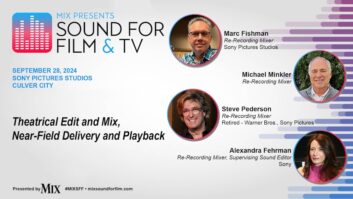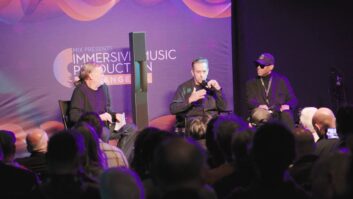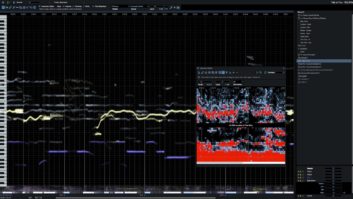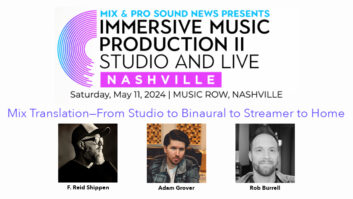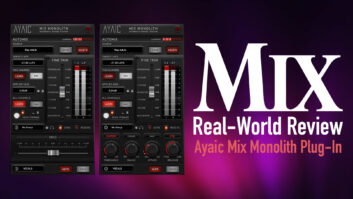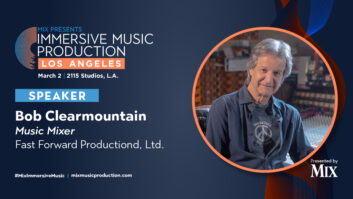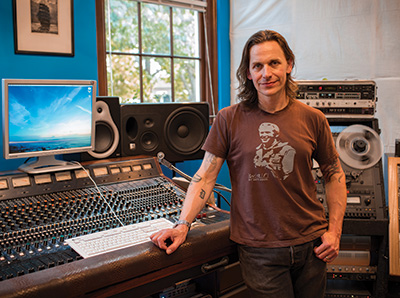
The Hallowed Halls Studio—tucked inside the historic Wikman Building in Southeast Portland—opened its doors on July 11. Erected in 1919, the building was the former Arleta Library, and then much later home to Multnomah County’s Department of Community Justice, which moved out in June 2011. The building was sold by the state to private owners in 2014, and, after extensive renovation, is now home to the Hallowed Halls Studio and Saint Frank’s Music—the studio’s boutique guitar and amp shop.
The building was also built as one of the Carnegie libraries. “It is literally a Carnegie Hall, complete with Victorian architecture, 18-foot ceilings and crown molding throughout,” says Hallowed Halls Chief Engineer Justin Phelps. The building is located the middle of Southeast Portland, a neighborhood that is home to a significant portion of the city’s music community. In the 1960s, Pete Seeger and Woody Guthrie did free concerts there, and over the years, the main hall was used for a lot of community parties and dances. The building was renamed the Wikman Building in the 1930s and was the first civic structure in the state of Oregon to be named after a woman, Lea Wikman.
The construction plans necessary to convert the historic library building into a multiroom facility were designed by Phelps, with the help of Abasi architectural design and former head technician at The Plant Studios, Perry Lancaster. “Great care was taken not to irreversibly alter to shell of the building, but the interior alterations were extensive,” says Phelps.

Studio A’s control room and two iso booths were constructed using triple-studded 2×6 framing and acoustic-grade rock-wool insulation. The control room, tracking room and iso booth in Studio B follow the same design. All electrical fixtures on the massive, 18-foot walls are surface-mounted, as are the low-voltage wire runs. The control room of Studio A and recording spaces in Studio B feature floated floors and independent air-conditioning systems for further isolation.
The main heating system in the building was updated from the basement on up to be silent but highly functional during recording sessions, using decoupling springs, acoustically absorbent ducting and custom diversion shells in the main tracking room. Most rooms were designed to take advantage of the flow of natural light, and the building’s 10-foot antique windows were isolated using airtight interior window caps. Power conditioning for the building is handled by Controlled Power series 700A processor, which was purchased from Bob Weir of The Grateful Dead at a generous discount. It runs through all of the studio spaces and Saint Frank’s Music.
Wiring for Studio A and B was primarily handled by Fred Johnson of FM Tech and house engineer Mike Blackburn, using Belden 9451, Mogami 8 pair cabling and Redco patchbays. “In addition to the web of tielines that spread to every possible recording space in the building—including the ominous death metal vocal/echo chamber in the basement and the glass cupola/vocal booth perched on top of the building—every room was also outfitted with Cat-6 connections for high-resolution data runs,” Phelps says.
The centerpiece of Studio A is a new Neve Genesys 48 console; the studio also features an Avid HDX system, Genelec 8260A monitors, an Otari MTR 90 Mk2, and an extensive collection of outboard gear including Universal Audio, Empirical Labs and Lexicon models. Studio B is primarily used as a mix/production room for Phelps but is also available for daily rental to outside engineers. It features a newly recapped Yamaha PM2000, Neve 8816, Avid Pro Tools HDX, a custom 16-channel ADM sidecar, JBL LSR32 monitors, and a lot of outboard gear by Daking, Universal Audio, Eventide, Telefunken and ADL, among others.
Hallowed Halls also has a large mic collection, including new and vintage mics by Telefunken, Neumann, AKG, Shure, Royer, ADK, Ear Trumpet Labs and Sennheiser. Headphones are handled by an 8-channel hear back system that runs through both Studio A and B, on the chance that they might ever need to be combined into one mega hall. The studios include a large collection of house instruments, including a Hammond B3, a baby grand piano, new and vintage guitar and bass amplifiers, and effects pedals, as well as all of the things that Saint Frank’s Music has to offer.

Ongoing and upcoming projects at Hallowed Halls include Phelps mixing new albums in Studio B for Fruition and Jelly Bread; Phelps tracking albums in Studio A for Lynx, Left Coast Country and Foxy Lemon; Big Al Carter and Warpfire doing album projects in Studio A and B with house engineer Mike Blackburn; producer/engineer Billy Anderson will be working in Studio A and B with Eight Bells; and Bike Thief will be tracking a new album this fall with a rotating cast of local engineers in Studio A.
The studio will also be taking advantage of its 1,600-square-foot main tracking room and recently expanded occupancy limit by hosting the Live From The Hallowed Halls concert series beginning in late September, as well as conducting seminars on Pro Tools, Ableton Live, Logic Audio and basic studio recording techniques.
